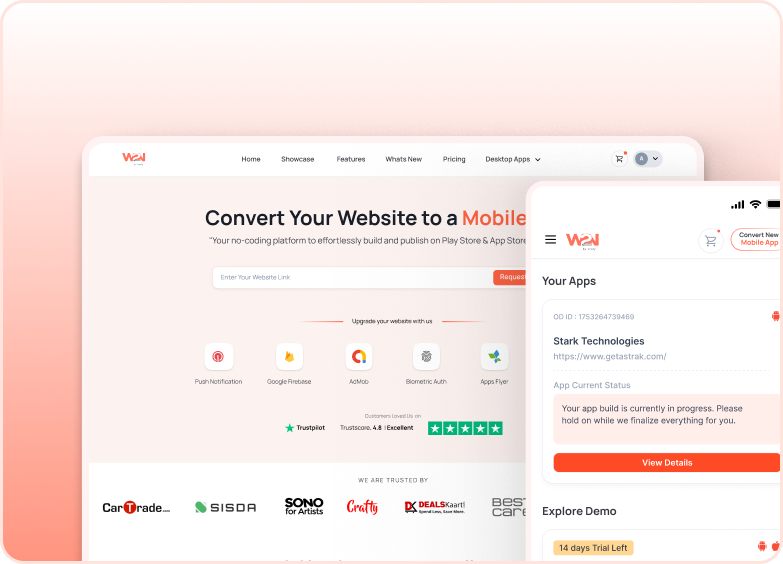Top 5 Mistakes to Avoid When Building Your First Mobile App
Author:
Vanshika Choudhary
24 December, 2024
Building your first mobile app is a fascinating experience, but it also comes with some challenges. From feature planning to a successful launch, even small mistakes can hinder your efforts and time. The 5 key mistakes will ensure a smooth launch of your app with enhanced usability to make you stand out in the market. In this blog, we will focus on the key mistakes to avoid when building your first mobile app.
Top 5 Mistakes to Avoid When Building Your First Mobile App
1. Improper Market Research
One of the key mistakes made by new developers is jumping into development without proper market research. This assumption that your app is unique and users will instantly start loving it will lead to a loss of resources and time.
Why is it a Mistake?
Without understanding your target audiences, audience requirements, and what your competitors offer, you can end up building an app that does not meet the needs of people.
How to Avoid Improper Market Research?
- Identify your target audience: Ask yourself who will use your app and whose problem your app is solving.
- Analyse your competitors: Review and explore similar apps to yours. View their strengths and weaknesses to make yourself better.
- Test your Concept: Conduct interviews, prototype testing, or surveys to ensure your app is solving the problem.
2. Overloading of Features
Everyone wants to make their app stand out in the market by offering a wide range of features to hold users for any problem, but this can backfire, making your app bulky and less user-friendly.
Why is it a Mistake?
An app overloaded with features tends to load slowly and is harder to use and maintain. Users preferred low-effort and easy-to-access solutions for their problems.
How to Avoid Overloading of Features?
- Focus on Essential features: Your primary focus should be on essential features that address your solutions.
- Add new features gradually: Add new features after receiving feedback from users.
- Apply the MVP framework: Launch an app with a Minimal Viable Product to test. It is a framework to test an app or its features before launching in the real world.
3. Neglecting UI/UX Design Principles
The design and user experience of your app decide whether the user will continue using the app or uninstall it. It depends on the app’s appearance and navigation within the app.
Why is it a Mistake?
Your app is difficult to perform actions and navigate within the app, or appears visually unappealing, which can make the user lose interest in the app, although you have the perfect solutions to the user’s problem.
How to Avoid Neglecting UI/UX Design Principles?
- Follow the design principles: While designing your app’s layouts and interfaces, use proven design principles such as clarity, simplicity, and consistency. UI/UX designers can create attractive interfaces and layouts tailored to design principles.
- Focus on the app’s interface: Your app’s interface should be captivating, and easy to navigate through the app with smooth interaction, making the user stop and look at what’s in your app.
- Test before launch: Test your app before launch to ensure that your app interface changes as designed and to detect if there are any bugs or fixes.
4. Failing Performance Optimisation
App’s Performance plays an essential role as it tailors how much users interact with the app. It should be ensured that your app does not have slow loading times and glitches, as these would not hold users around your app.
Why is it a Mistake?
Slow loading times and frequent glitches can lose users and search visibility of the app.
How to Avoid Failing Performance Optimisation?
- Test Your App: Test your app in the span of days or months to identify bugs or fixes across platforms and devices, ensuring the app functions smoothly.
- Refined Resources: Refined resources include compressed images or media to download fast and maintain the codebase properly.
- Provide offline support: If it is possible to provide users access to some basic features even with no internet connection.
5. Fail to Plan for Marketing and Monetisation
A great app is made with proper planning for marketing and monetisation. Most of the developers give primary focus on building an app, but forget how it will be marketed in the market and generate revenue from it.
Why is it a Mistake?
Your app is perfect and goes a long way, but it lags because of an improper marketing strategy. Without a proper monetisation strategy, an ideal app cannot survive in the long run and market.
How to Avoid Failing to Plan for Marketing and Monetisation?
- Early Marketing Planning: Use Marketing Planning early on social media platforms through coming soon reels and launching your app, and integrate keywords to gain attention and come to users' eyes and search engines.
- Choosing the right Revenue Plan: Choose the right revenue plan that suits your app, including in-app purchases, subscriptions, and paid apps.
- Keep in Touch: Remind users about your existence with email notifications, push notifications, and app updates.
Conclusion
Launching your first mobile app is exciting, yet it comes with a lot of challenges that require proper planning. Every big and small detail can make your app succeed in the long run or lose market presence. Improper market research, overloading features, UI/UX design, app performance, and marketing and monetisation strategies are some of the common mistakes that are neglected by developers. These are not just mistakes; these are some of the best practices to keep in mind while building your first mobile app.
If you are looking for an efficient way to bring your app to the real world, it is possible with WebToNative. It offers no-code app build solutions that will save your effort and time, avoiding these mistakes and tailoring a smooth app launch.
Similar Blogs




